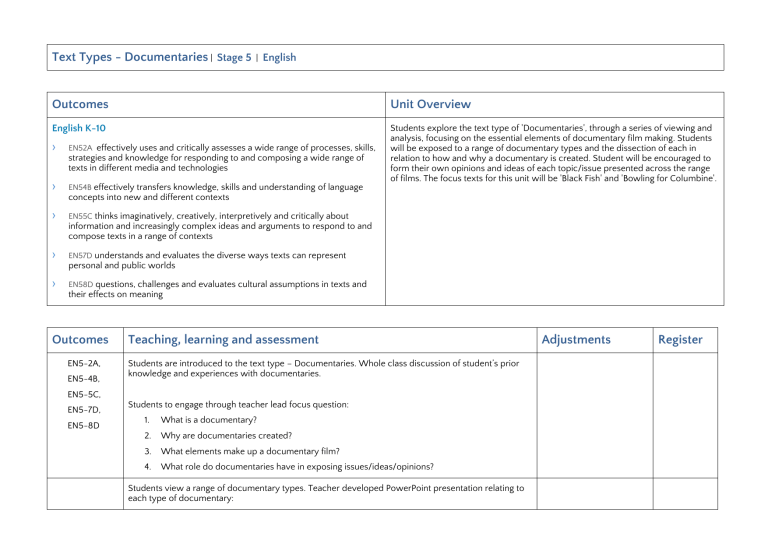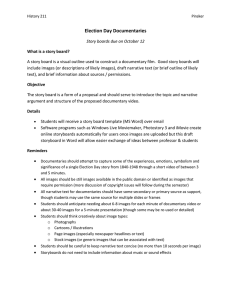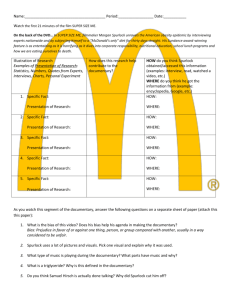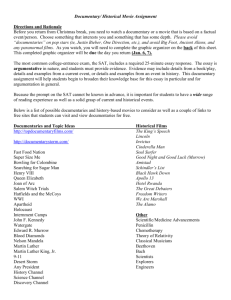
Text Types - Documentaries | Stage 5 | English Outcomes Unit Overview English K-10 Students explore the text type of 'Documentaries', through a series of viewing and analysis, focusing on the essential elements of documentary film making. Students will be exposed to a range of documentary types and the dissection of each in relation to how and why a documentary is created. Student will be encouraged to form their own opinions and ideas of each topic/issue presented across the range of films. The focus texts for this unit will be 'Black Fish' and 'Bowling for Columbine'. › EN52A effectively uses and critically assesses a wide range of processes, skills, › EN54B effectively transfers knowledge, skills and understanding of language › EN55C thinks imaginatively, creatively, interpretively and critically about › EN57D understands and evaluates the diverse ways texts can represent › EN58D questions, challenges and evaluates cultural assumptions in texts and strategies and knowledge for responding to and composing a wide range of texts in different media and technologies concepts into new and different contexts information and increasingly complex ideas and arguments to respond to and compose texts in a range of contexts personal and public worlds their effects on meaning Outcomes EN5-2A, EN5-4B, Teaching, learning and assessment Students are introduced to the text type – Documentaries. Whole class discussion of student’s prior knowledge and experiences with documentaries. EN5-5C, EN5-7D, EN5-8D Students to engage through teacher lead focus question: 1. What is a documentary? 2. Why are documentaries created? 3. What elements make up a documentary film? 4. What role do documentaries have in exposing issues/ideas/opinions? Students view a range of documentary types. Teacher developed PowerPoint presentation relating to each type of documentary: Adjustments Register ● Poetic: First seen in the 1920s, Poetic Documentaries are very much what they sound like. They focus on experiences, images and showing the audience the world through a different set of eyes. Abstract and loose with narrative, the poetic sub-genre can be very unconventional and experimental in form and content. The ultimate goal is to create a feeling rather than a truth. ● Expository: Expository Documentaries are probably closest to what most people consider “documentaries.” A sharp contrast to poetic, expository documentaries aim to inform and/or persuade. This mode includes the familiar Ken Burns and television (e.g. History Channel) styles. ● Observational: Observational Documentaries are exactly what they sound like — they aim to simply observe the world around them. The style attempts to give voice to all sides of an issue by giving audiences first hand access to some of the subject’s most important (and often private) moments. ● Participatory: Participatory Documentaries, while having elements of Observational and Expository, include the filmmaker within the narrative. This could be as minor as the filmmaker’s voice being heard behind the camera, prodding subjects with questions or cues — all the way to the filmmaker directly influencing the major actions of the narrative. ● Reflexive: Reflexive Documentaries are similar to Participatory in that they often include the filmmaker within the film — however, unlike Participatory, they make no attempts to explore an outside subject. Rather, they focus solely on themselves and the act of them making the film. ● Performative: Performative Documentaries are an experimental combination of styles used to stress subject experience and share an emotional response to the world. They often connect personal accounts or experience juxtaposed with larger political or historical issues. This has sometimes been called the “Michael Moore” style, as he often uses his own personal stories as a way to construct social truths. Students to view a brief example of each type, this could be a short documentary or an extract. Students research in the elements of Documentary film making e.g. ● Interviews ● Cutaways ● ‘Cinema Verite’ - live action ● Process footage ● Archive footage Teacher guided terminology. Students to demonstrate their understanding of film techniques directly relating to documentaries. ⮚ Reenactments ⮚ Direct to camera interview ⮚ Camera shot size (long shot, close up etc.) ⮚ Camera angle ⮚ Camera movement ⮚ Camera speed ⮚ Non-diegetic sound ⮚ Diegetic sound ⮚ Transitions between shots ⮚ Special effects ⮚ Super imposed titles ⮚ Captions Students should be encouraged to define these as best they can and advise them that they will be using these terms in analysis as the unit progresses. Students view a range of documentaries. At least one of each type if possible. Completing the ‘Analysis Template’ each time, using the terminology from above. Examples could include: - Planet Earth https://www.youtube.com/watch?v=2pAqc9BqroE - Bog Bodies https://www.youtube.com/watch?v=lYAz9i40pBA - Madeleine McCann https://www.youtube.com/watch?v=Z61FV8AAEoc - Cyclone Tracy: Disasters of the Century https://www.youtube.com/watch?v=gRXltc7AuDY&t=703s - Time team https://www.youtube.com/watch?v=60GFYLFdxbk Students explore synopsis and trailers of focus films, Black Fish and Bowling for Columbine. Student view (no analysis) each film, then re-view with detailed analysis. Students to complete viewing questions for each film also. Students research reviews and articles on each film to form individual opinions of the topics and issues presented and how well/not well the documentary demonstrated this. Activity: Students create their own documentary film. Topic focusing on students’ weekly activities, A day in the life of…. 1. Storyboard/draft 2. Decide on type of text 3. Film/develop film using documentary techniques 4. Script can be used if no accessible technology (BYOD) Students can use phone, video, snapchat etc. Evaluation




